Baby Care & Parenting Blogs
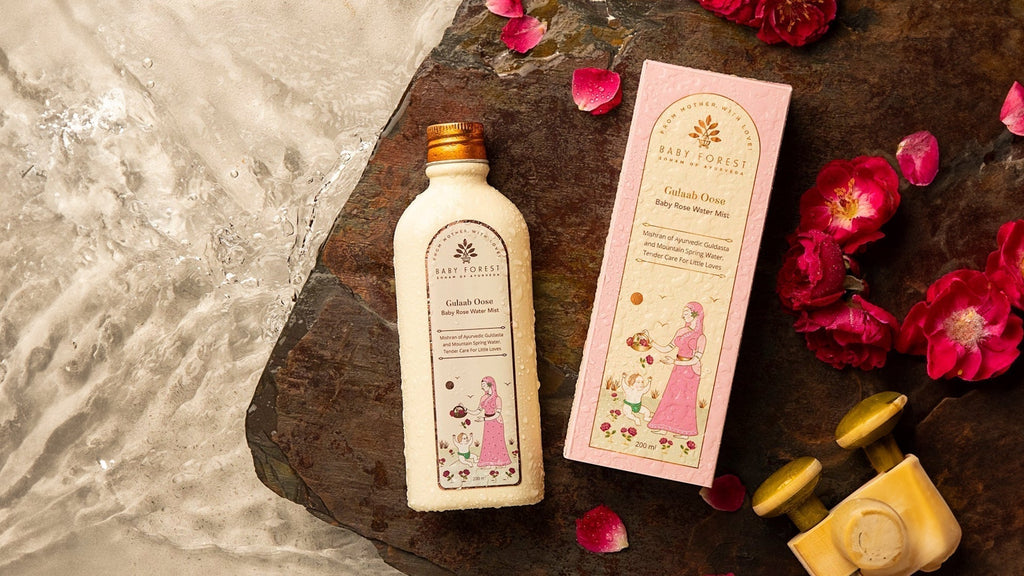
Benefits of Baby Rose Water for Your Little One
Caring for your baby's skin is as essential as nurturing their health. In a world teeming with baby skin care products, finding the gentlest and most natural option for your little one can be a challenge. Among the myriad choices, baby rose water stands out as a remarkable solution that not only pampers but also benefits your baby's delicate skin.
Crafted from the essence of native rose petals, it brings nature's best to your baby's skincare routine. Here are a few
Benefits of incorporating baby rose water into your daily routine:
-
Soothing Calmness
The core ingredient, Rosa Damascena flower water, is renowned for its calming properties. Native rose petals are carefully selected and distilled to create rose water and it offers a soothing touch to your baby's skin. The natural fragrance of roses is not just a scent but a sensory experience that calms the mind and body. It's like wrapping your baby in a soft, fragrant hug that soothes them into peacefulness. The delicate aroma of roses also ensures your baby enjoys a luxurious, calming bath time, making it a serene ritual.
-
Hydration and Nourishment
Baby rose water is a fantastic hydrator. Due to its vital formulation, enriched with Vitamin E, it aids in preserving the skin's moisture barrier, which helps in avoiding dryness and ensures the skin remains smooth and pliable. This works as a natural moisturizer that absorbs easily without leaving any greasy residue, ensuring your baby's skin remains hydrated and nourished. -
Natural and Safe Ingredients
When choosing rose water for your baby, it's crucial to opt for a product with natural and safe ingredients. A formula comprising Rosa Damascena Flower Water and Vitamin E, without any added chemicals, is ideal. This ensures that the product is gentle on your baby's skin and free from any harmful substances. By selecting a natural, cruelty-free, and derma safe rose water, you provide your baby with the safest and most loving care.
-
Versatility
Its natural soothing properties make it an excellent choice for various situations – from diaper changes to after bath time, ensuring your baby's skin remains clean, calm, and refreshed. On hot and humid days, a quick spritz of rose water can provide an instant refreshment for your baby, helping to cool and soothe their delicate skin. The gentle fragrance of rose water also adds a mild, pleasant scent that can comfort and relax your baby, making it a perfect, all-natural way to enhance their overall well-being and comfort throughout the day.
Pro Tip for Using the Gulaab Oose - Baby Rose Water Mist:
To enhance the nourishment and softness, combine a few drops of the rose water mist with Loi Ubtan Powder and gently massage it into your baby's skin. This blends not only hydrates but also leaves the skin incredibly soft, supple, and with a healthy glow. It's a simple yet effective way to enhance the natural benefits of rose water, providing your baby with the ultimate skincare treatment.
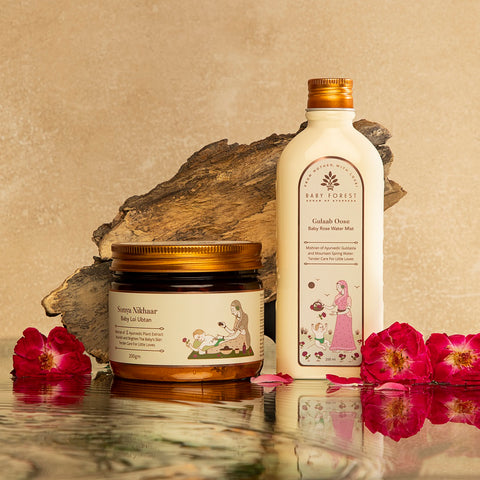
Related Read - Baby Loi Ubtan: Traditional & Modern Care for Stylish Moms
Selecting the appropriate skincare products for your baby is crucial. By choosing a product that is natural, cruelty-free, and free from harsh chemicals, you're guaranteeing that your baby benefits from the finest offerings of nature. Incorporate baby rose water into your baby's skincare routine for a touch of nature's gentleness and purity, embracing its benefits for a happy, healthy baby.
Whether you're a new parent looking for inspiration for the perfect baby shower gift ideas or simply looking for any essential baby care product, like the best baby lotion, our resources are designed to guide you every step of the way.
You can also read more about the traditional and modern significance of using a mustard seed pillow for your little one and explore its various benefits. Or, if you're interested in understanding the richness of Indian ceremonies for your child, our detailed guides on the Annaprashan ceremony and Mundan ceremony will offer insights and practical tips to celebrate these milestones for your little one.
You can read more blogs to ensure that your parenting path is well-informed, joyful, and rich in tradition and care.

The Benefits of Using Water Wipes for Your Baby's Delicat...
In the life of a new parent, every choice made for their little one holds immense significance, especially when it comes to their comfort and health. One such pivotal decision revolves around selecting the right kind of baby wipes for the baby's delicate skin. There are numerous baby products available online, so it becomes crucial to understand why water wipes stand out as the optimal choice for your infant's hygiene and well-being.
Understanding the Delicate Nature of Your Baby's Skin
The skin of a baby is more sensitive when compared to an adult. It is more prone to irritation and allergic reactions when exposed to harsh chemicals commonly found in traditional baby wipes. This is where water wipes come into play. Infused with purified water and natural ingredients like aloe vera extract, these wipes offer a gentle yet effective solution for cleaning your baby without causing any harm.
The Purity of Water Wipes
Water wipes are designed with your baby's health in mind. They are predominantly made of purified water, typically over 99%, ensuring that the wipes are free from harmful chemicals and irritants. The simplicity of water combined with the natural soothing properties of aloe vera makes these wipes ideal for frequent use, reducing the risk of diaper rash and skin irritations.
Ultra-Soft Bamboo Fabric
The choice of material in baby wipes is as crucial as the ingredients. Ultra-soft bamboo fabric is renowned for its natural properties: it's anti-bacterial, hypoallergenic, and, most importantly, incredibly gentle on your baby's skin. Unlike traditional materials, bamboo fabric is more absorbent, ensuring a cleaner wipe with less rubbing, thus preventing redness or inflammation.
No Added Fragrance
Many baby wipes come with added fragrances, which, while pleasant, can lead to skin irritations or allergic reactions. Water wipes, especially those that are unscented, eliminate this risk, making them safe for even the most sensitive skin. By choosing fragrance-free wipes, parents can avoid unnecessary chemicals and ensure a pure and natural cleaning experience for their babies.
Dermatologically Tested
When selecting baby wipes, look for those that are dermatologically tested and approved. This certification attests to their safety, assuring that they are devoid of alcohol, parabens, and other harsh chemicals that may harm your baby's skin. It gives parents peace of mind, knowing that the wet wipes for babies they use have been tested and proven to be gentle and safe for newborns and babies with sensitive skin.
Free from Harmful Chemicals and Alcohol
The absence of harmful chemicals and alcohol in water wipes further underscores their suitability for newborns. Alcohol, commonly found in various cleaning products, can cause drying and irritation to delicate skin. By choosing water wipes, parents can ensure their baby's skin remains hydrated and protected from potential irritants found in conventional wipes.
Environmental Impact and Sustainability
Using bamboo-based water wipes benefits both your baby's skin and the environment. Bamboo is a sustainable and biodegradable material, making these wipes an eco-friendly alternative to traditional options. By opting for water wipes, parents are making a conscious choice to protect their baby's health and contribute positively to the planet's well-being.
How to Use Baby Forest Neer 99.9% Water Baby Wipes
Using Baby Forest Neer 99.9% Water Baby Wipes is a simple and effective way to keep your baby clean and refreshed, whether at home or on the go. Start by opening the lid located at the top of the pack to access the moisture-rich wipes. Gently pull out a single wipe, ensuring that the rest remains covered. Close the lid firmly after each use to retain the wipes' moisture and prevent them from drying out. Use the wipe to gently clean your baby's skin, including the bottom, face, and hands, effectively removing dirt, germs, and impurities. These wipes are designed for delicate skin, making them suitable for frequent use. Dispose of the wipe responsibly after use, and ensure the pack is sealed to maintain the high quality of the remaining wipes.
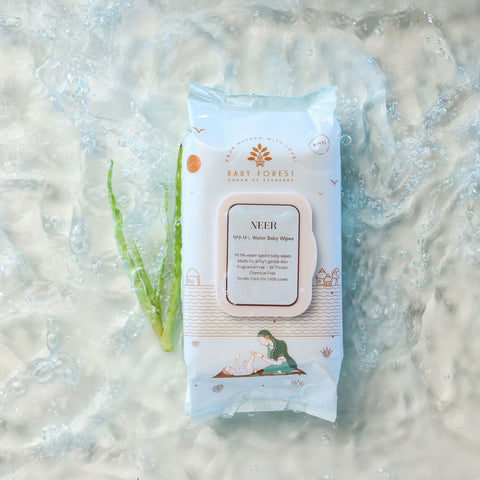
Final Thoughts
The journey of parenthood is full of decisions that shape the health and happiness of your baby. Selecting the right baby wipes is a small yet significant part of this journey. Water wipes, particularly those crafted from ultra-soft bamboo fabric and infused with purified water and aloe vera, offer a safe, gentle, and eco-friendly solution for maintaining your baby's hygiene and comfort.
In embracing water wipes, you are choosing a baby product that aligns with the delicate nature of your baby's skin while supporting sustainable practices. Remember, in the vast sea of choices, the simplest ones are often the best for your baby and the environment.
As you navigate through the early stages of parenthood, let your love and care for your baby guide your decisions. By opting for water wipes, you are ensuring a gentle, pure, and loving touch for your baby's delicate skin, reinforcing your commitment to their health and happiness.
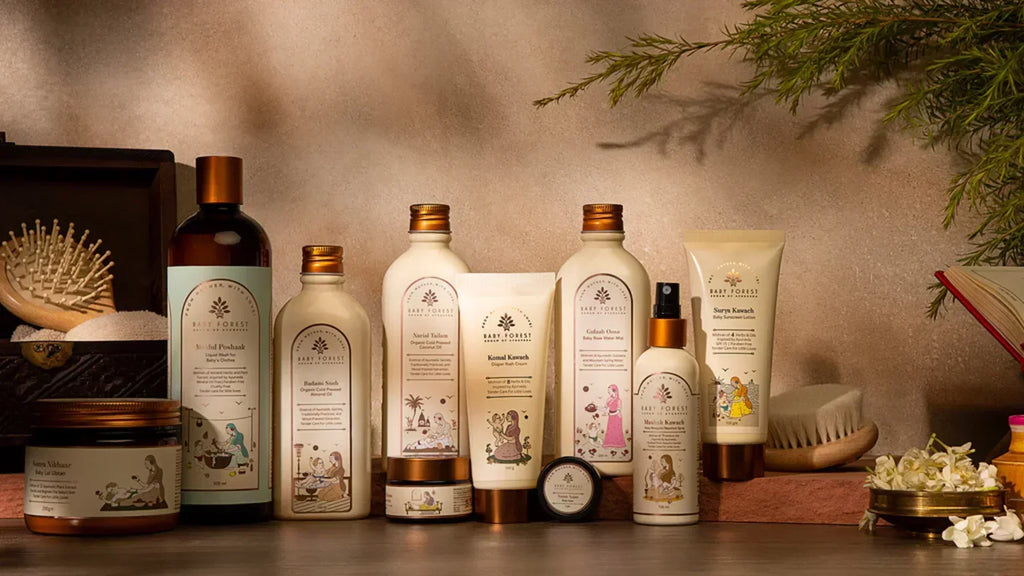
How to Pick Safe Essential Baby Care Products
Navigating the vast world of baby care products can be overwhelming for new parents. You want the best for your little one, ensuring every product, from their lotion to their toys, is safe, gentle, and beneficial for their development. This guide aims to simplify the whole process for you, providing you with the knowledge to choose the best baby products, focusing on safety, natural ingredients, and the well-being of your newborn.
Understanding Baby Care Product Safety
The safety of baby care products lies in their ingredients and materials. Go for products that are free from harmful chemicals and dyes, which can irritate delicate skin or cause allergic reactions. Look for certifications and labels that guarantee products are tested and safe for babies. Reading reviews and researching baby products online can also offer insights into their safety and efficacy.
Essentials for a Safe Nursery
Creating a safe nursery goes beyond aesthetics. It includes choosing organic bedding, hypoallergenic mattresses, and non-toxic paints. Ensure that all furniture is sturdy and meets safety standards. Air purifiers can also contribute to creating a clean, safe environment by reducing potential airborne irritants.
Safe Skincare and Bathing Practices
Babies' skin is incredibly sensitive, requiring products that moisturize and protect without causing harm. Natural and ayurvedic baby skincare products, such as baby face cream and baby lotion made with ingredients such as chamomile, aloe vera, and coconut oil, offer gentle hydration. For bathing, opt for mild, tear-free baby shampoo and baby body wash that cleans without stripping natural oils. Always test products on a small skin area first to check for any reactions.

Choosing Safe Clothing and Diapers
Selecting clothing and diapers for your baby involves more than just comfort and design. Choose organic cotton or bamboo fabrics that are soft, breathable, and free from harmful chemicals. When it comes to diapers, consider cloth options or chemical-free disposables that offer high absorbency without risking diaper rash or exposure to irritants.

Safe Feeding Practices
Feeding your baby safely is paramount. Glass feeding bottles offer a reliable alternative to plastic, mitigating the risk of BPA exposure. When your baby progresses to solids, bamboo baby feeding bowls provide durable and non-toxic choices. Bamboo bowls are especially favoured for their eco-friendly and biodegradable qualities, making them a safe choice for your baby and the environment. Remember to sterilize feeding items thoroughly to ensure they remain hygienic for your baby's use.

Safe Playtime Essentials
Toys play a significant role in your baby's development, but choosing safe playtime essentials is key. Look for toys made from natural materials like organic cotton crochet toys or food-grade silicone. These materials are not only safer but are also environment friendly. Stacking toys, soft books, and sensory balls are excellent for stimulating your baby's senses without the worry of harmful substances.
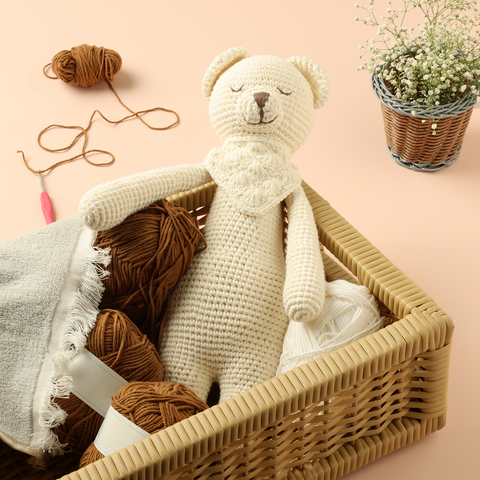
Choosing safe, essential baby care products is a journey filled with love and care. By prioritizing products that are natural, free from harmful chemicals, and designed with your baby's health in mind, you can create a nurturing environment for your little one to grow and thrive. Whether you're purchasing baby skin care products, setting up the nursery, or selecting toys, remember that simplicity and safety go hand in hand. With the correct information and a conscious attitude, you can confidently explore the vast choices of newborn baby products, assuring that you only choose the best for your precious bundle of joy.
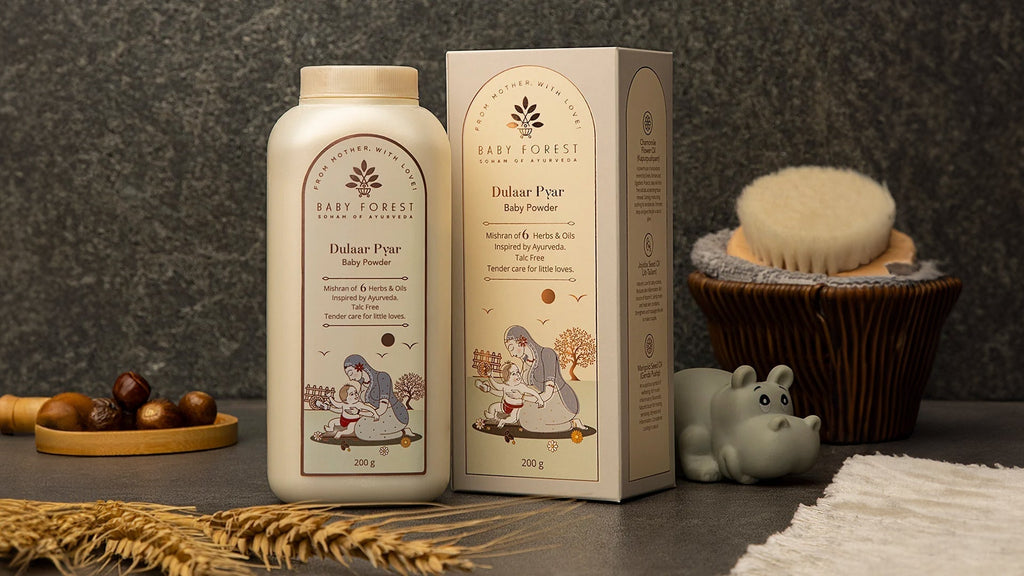
Why Talc-Free Baby Powder Is the Ideal Choice for Infants
When it comes to selecting baby products, parents invariably seek the finest, safest options for their cherished little ones. A significant amount of time is dedicated to meticulously researching and choosing products that promise to be gentle and nurturing for their baby's sensitive skin. Among these products, baby powder has stood as a household staple for generations. Yet, it's crucial for parents to exercise caution, particularly with powders containing talc, as not all baby powders are created equal in terms of safety.
Baby powder, a staple in many households, has come under scrutiny, leading to a shift towards talc-free baby powder. This article delves into why talc-free baby powder is the best choice for your infant, incorporating natural, safe, and gentle ingredients for your peace of mind.
The Shift to Talc-Free
In recent years, the safety of talc-based products has been questioned, prompting parents and manufacturers alike to seek safer alternatives. Talc-free baby powder has emerged as an ideal choice, offering the same benefits without the potential risks associated with talc. But what makes talc-free powder the superior option for infants?
Understanding Talc-Free Baby Powder
Talc-free baby powder is made without talc, a mineral comprised of magnesium, silicon, and oxygen. Instead, it relies on natural and safe alternatives like corn starch, which provides the absorbency and smoothness for which baby powder is known without the associated health concerns.
The Benefits of Going Talc-Free
-
Health and Safety
Talc-free baby powder is gentler on your baby's delicate skin. With no talc as an ingredient, it eliminates the risk of respiratory issues or adverse skin reactions, making it a safer choice for daily use. -
Natural Ingredients
Talc-free baby powders often contain natural ingredients such as chamomile oil, jojoba oil, aloe vera, marigold seed oil, oats kernel, and corn starch. These ingredients not only help in keeping the baby's skin dry but also soothe and nourish it, enhancing the skin's natural barrier. -
Cruelty-Free and Eco-Friendly
Many talc-free baby powders are also cruelty-free, not tested on animals, and are environmentally friendly. This commitment to ethical practices adds an additional layer of appeal for conscientious parents.
Choosing the Best Powder for Your Baby
When selecting a baby powder, looking for talc-free options is just the beginning. The best baby powder for your infant is one that is not only safe but also nourishing for their skin.
-
Chamomile Oil:
It has soothing effects and can help soothe sensitive skin, making it an ideal element in baby powder. -
Corn Starch:
A natural absorbent, corn starch effectively absorbs moisture, keeping your baby's skin dry and comfortable. -
Jojoba Oil:
This oil closely mimics the skin's natural oils, providing moisturization without clogging pores or causing irritation. -
Aloe Vera:
Aloe vera's healing and soothing characteristics make it ideal for treating diaper rash and other skin irritations. -
Marigold Seed Oil:
Known for its anti-inflammatory properties, marigold seed oil can help reduce redness and promote skin healing. -
Oats Kernel:
Oatmeal not only offers comfort but also contains components that can shield the skin and avert irritation.
Tips for Using Talc-Free Baby Powder
-
Apply with Care
To avoid inhalation, sprinkle the powder on your hands away from your baby before applying it to their skin. -
Focus on Moisture-Prone Areas
Apply baby powder to areas that tend to retain moisture, such as the diaper region, underarms, and skin folds. -
Choose Containers Wisely
Opt for powders in shaker bottles or containers that allow for controlled dispensing to minimize airborne particles.
Addressing Common Concerns
With the transition to talc-free baby powders, some parents may wonder about the effectiveness of these natural alternatives. Rest assured, talc-free powders are equally effective in absorbing moisture and preventing diaper rash. The key is in the quality of the formulation and the blend of natural ingredients used.
Choosing talc-free baby powder helps to ensure your infant's safety and comfort. With natural ingredients that soothe, protect, and care for delicate skin, talc-free powders offer parents a worry-free option for keeping their babies dry and comfortable. As you begin on the road of motherhood, choosing products that meet the highest safety and care requirements demonstrates your love for and devotion to your child's well-being. Remember, the best baby powder is one that keeps your baby happy, healthy, and smiling naturally.

A Guide to Creating the Perfect Sleep Space for Your Baby
As new parents, one of the greatest gifts you can give your baby—and yourselves—is the gift of good sleep. Creating the perfect sleep space for your baby is about more than just aesthetics; it's about fostering a safe, comfortable, and soothing environment that promotes sleep. From choosing the right sleeping gear to establishing a cosy bedtime routine, this guide will help you understand the essentials of setting up a nurturing sleep space for your little one. Incorporating key elements such as how to make baby sleep, ensuring the baby's sleeping position is safe, sleep training baby techniques, and the art of swaddling baby for sleep, we aim to provide you with the knowledge to enhance your baby's sleep quality.
Choosing the Right Sleeping Gear
-
Selecting a Cozy Crib or Bassinet
The crib or bassinet is the centrepiece of your baby's sleep space. Look for a sturdy, well-constructed model that meets safety standards. Ensure it has a firm mattress and fits snugly within the crib or bassinet to prevent any gaps. -
Optimal Bedding Choices
Choose soft, breathable materials for the bedding to ensure your baby remains comfortable throughout the night. Avoid overly plush fabrics that can overheat or pose a suffocation risk. -
Wool Blankets
Wool blankets can keep you warm in winter but trap too much heat in summer. They are great at controlling temperature. Ensure the baby blanket is lightweight and breathable. -
Mustard Pillow
Head shaping mustard pillow can be a great addition since it helps with flat-head syndrome prevention by providing gentle support to distribute the baby's head pressure evenly.
Setting Up a Comfortable Sleep Zone
-
Arranging the Crib or Bassinet
Place the crib or bassinet in a quiet corner of the room, away from windows, heaters, and any cords. This positioning helps in creating a calm, undisturbed sleep area. -
Ensuring Proper Ventilation
Good air circulation is crucial for a comfortable sleep environment. Ensure the room is well-ventilated, maintaining a room temperature that is neither too hot nor too cold.
Creating a Relaxing Sleep Atmosphere
-
Soft Lighting
Use soft, dimmable lighting in the sleep space to help soothe your baby to sleep. Harsh lighting can be stimulating and disrupt the sleep process. -
White Noise or Gentle Sounds
White noise for newborns or other soft, relaxing sounds can be used to block out distracting stimuli and provide a peaceful sleeping environment. Devices designed for baby sleep are widely available and can be very effective.
Dressing Your Baby for Sleep
-
Choosing Appropriate Sleepwear
Select sleepwear that's appropriate for the room's temperature, opting for lightweight, breathable fabrics that won't overheat your baby. -
Swaddling Techniques
Swaddling can provide comfort and security, helping babies to sleep more soundly. Learn safe swaddling techniques to ensure your baby's hips and legs can move freely and avoid overheating. Use a super soft bamboo muslin fabric for your baby’s swaddle because it is lightweight and breathable bamboo muslin fabric lets your baby regulate their body temperature, promoting a comfortable and restful sleep.
Nighttime Routines for a Cozy Sleep Space
-
Establishing Consistent Bedtime Rituals
A consistent bedtime routine can significantly aid in baby sleep training efforts. Bathing, reading, or gentle massages can signal to your baby that it's time to wind down. -
Creating a Sense of Familiarity
Consistency and familiarity help babies feel secure. A predictable sleep environment and routine can make bedtime a much smoother process.
Transitioning to a Crib
As your baby grows, transitioning from a bassinet to a crib is a natural step. Make this transition gradually, starting with naps in the crib to familiarize your baby with the new sleep environment.
Keep in mind every baby is different, so what helps one baby sleep might not help another the same way. Be patient, and don't hesitate to adjust your approach as you learn what makes your baby sleep most peacefully. With love, care, and attention to detail, you can create a haven that supports your baby's sleep needs, laying the foundation for healthy sleep habits that can last a lifetime.

Dealing with Cradle Cap: Causes, Treatment Options, and P...
One common puzzle that many new parents encounter is the cradle cap. This harmless but often perplexing condition can leave tiny scalps looking a bit flaky. In this article, we'll understand cradle cap, its causes, treatment options, and proactive measures parents can take to keep their little one's scalp healthy and happy.
What is a Cradle Cap?
Cradle cap, scientifically termed seborrheic dermatitis, is a prevalent skin condition that commonly manifests in infants within the initial months of their lives. This condition is typically identified by the presence of yellowish, greasy scales on a baby's scalp, making it look like a mild case of dandruff. Though a cradle cap isn't itchy or painful for your baby, it can understandably cause concern for parents.
A cradle cap tends to make its debut in the first few weeks of a baby's life and can persist for a few months. While it might be a bit unsightly, the good news is that the cradle cap in infants is temporary and usually resolves on its own without causing any long-term issues for your little one.
Cradle cap tends to impact approximately 10 per cent of newborns within their first month, with the prevalence soaring to 70 per cent by the time they reach three months old. Surprisingly, the occurrence diminishes significantly to only 7 per cent in infants aged 1 to 2 years.
Causes of Cradle Cap
-
Sebum Overproduction
One of the primary causes of cradle caps is the excess production of sebum, a natural oil that the skin produces. In newborns, the sebaceous glands can go into overdrive, resulting in an excess of this oily substance. When dead skin cells mix with sebum, it results in the characteristic yellowish crust seen in the cradle cap. -
Fungal Involvement
The presence of a fungus known as Malassezia, which resembles yeast, is considered to be another factor that contributes to the problem. While harmless, this fungus can exacerbate the production of sebum and contribute to the development of cradle caps.
-
Environmental Factors
Environmental elements, such as alterations in weather conditions or exposure to abrasive shampoos, can contribute to the onset or exacerbation of cradle cap. Parents can take proactive measures to handle the condition by comprehending and addressing these factors effectively.
Treatment Options for Cradle Cap
Gentle Shampooing
A simple yet effective way to manage cradle caps is through gentle shampooing. Opt for a mild, organic baby shampoo, using warm water to soften the scales before gently massaging and rinsing the scalp.

Scalp Massage
Gently massaging your baby's scalp with your fingers using a natural hair massage oil can help loosen and lift the scales. Massage with a natural and baby friendly hair oil not only aids in the removal of cradle caps but also provides a comforting and bonding experience for both parent and baby.
Brushing or Combing
Using a soft baby brush or comb, carefully brush through the baby's hair to remove loose scales. Be gentle to avoid irritating the scalp, and always ensure the tools are clean and safe for your little one. The Sunehere Resham baby comb is a wooden hairbrush made of natural elements with super soft bristles for infants and kids. It gets rid of the cradle cap and releases natural oils in the baby’s hair and skin without damaging or scratching.

Natural Remedies
For parents who prefer natural remedies, applying a small amount of coconut oil or almond oil to the affected areas before washing can help soften and loosen the scales. Always test a small patch to ensure your baby doesn't have any adverse reactions.
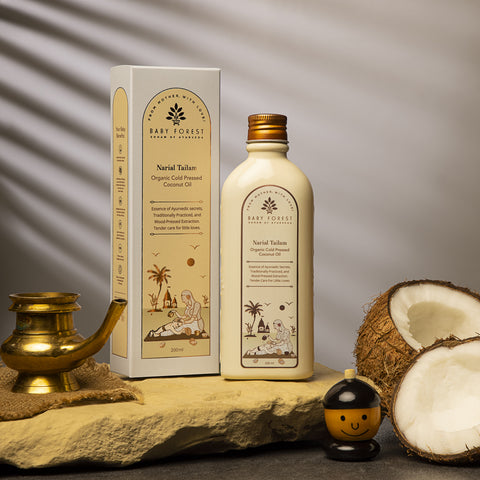
Choosing Organic Baby-Friendly Products
Opting for organic baby products can make a significant difference in preventing and managing cradle caps. Look for shampoos and skincare items with natural ingredients, free from harsh chemicals that could potentially worsen the condition.
When to Consult a pediatrician
While cradle caps are generally harmless, consult your pediatrician if you notice persistent redness or inflammation or if the condition spreads beyond the scalp. In rare cases, a prescription medication may be recommended.
A cradle cap may be a temporary visitor on your baby's scalp, but understanding its causes and treatment options can empower you as a parent. Embrace a gentle and organic approach to your baby's skincare routine, promoting a healthy scalp from the start. By incorporating these proactive measures, you can ensure that the cradle cap becomes just a fleeting moment in your parenting journey, leaving you with a happy and content baby.
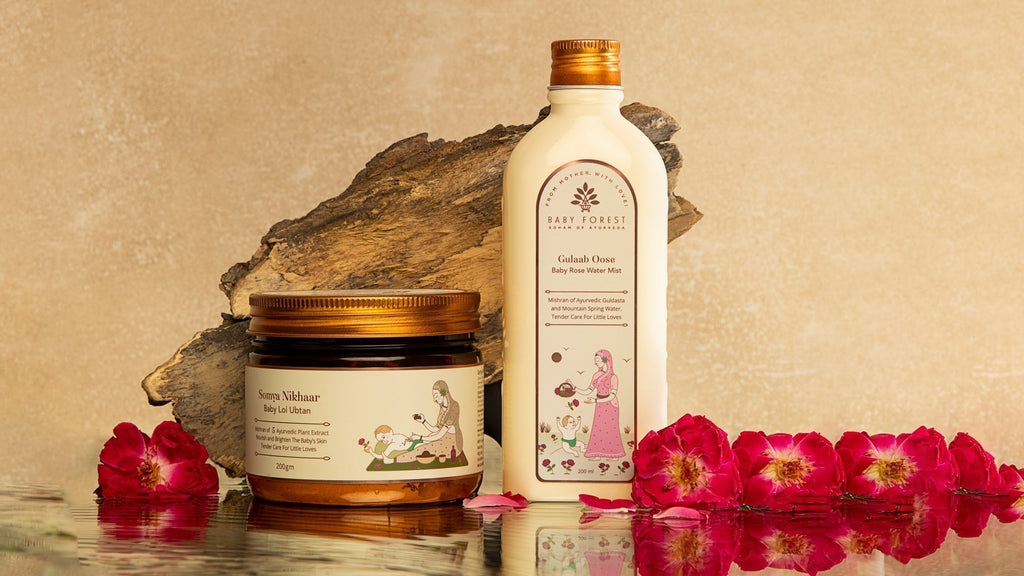
Baby Loi Ubtan: Traditional & Modern Care for Stylish Moms
We all have at least one dainty memory of our Dadi maa or Nani maa rubbing the back of an infant with wheat atta loi, especially on a baby's forehead. Since babies are as delicate as rose petals, removing the excess baby hair by loi is pain-free. For these fragile and initial days, using wheat atta lLoi for babies is a perfect Indian tradition with an optimum amount of tenderness! Not as typical as it sounds, a loi is just a tiny amount of wheat dough rolled into a ball and dipped into oil of preference for giving a loi massage to your little one.
The Tradition of Loi in India
The tradition of rubbing a loi has its roots in the ancient heritage of baby care. You must have heard those tales about strong babies with strong muscles during childhood. Well, the seeds of that strength are sowed right in the newborn's first month. The soft massage allows them to handle the force provided by human hands in the next few months. The primary function of this practice is the removal of excess baby hair. But it has several other benefits. The soft atta lLoi takes care of the blood circulation in the most delicate way possible, reducing body hair growth. Along with it, it protects the baby from various toxins as well.
Types of Loi
Just like how every grandma and maa has her own best ways for their babies, the custom of lLoi is also different in every household. Some mothers use oils like sesame, mustard, and coconut oil to dip the dough. In contrast, others believe in adding a pinch of turmeric for protection. The goodness of these ingredients and natural plant extracts is what curates Baby Forest's Baby Loi Ubtan. We bring the concept of Loi and the nourishment of ubtan together in this magical box. Our ayurvedic composition of five ayurvedic plant extracts like wheat, turmeric, besan, licorice powder, and vetiver provides babies with tender care and saves their mothers some time.
Why should you choose Baby Forest's Loi Ubtan?
This Loi Uubtan is unique in its ingredients, texture, and fragrance. Starting with wheat flour, it helps to remove extra hair and acts as an antioxidant and cleanser. Turmeric does its wonder by improving the skin texture of the baby. From the forest of flour, gram flour enhances the skin's softness. At the same time, licorice and vetiver help as a natural coolant and prevent inflammation with their neutral oils. The powdered texture makes it handy and easier to use. You don't have to miss your baby's massage while traveling. The most distinctive advantage of the product is that you can pair it with our Gulaab Oose. The richness of traditional paatalam pushpah cohered with the mishran of vetiver creates a mystical fragrance that is both safe and soothing for the baby and the mother.
Step-By-Step Guide for The Proper Use of Baby Loi Ubtan

Step 1- Take two big spoons of Somya Nikhaar Baby Loi ubtan.

Step 2- Mix the ubtan with the desired quantity of Baby Forest rosewater and purified water.
![]()
Step 3- Create a thick paste and knead soft dough for the baby.

Step 4- Rub that loi in a circular motion on the baby's back, forehead, legs, and arms.
Note: Rub a Loi after giving an oil massage to your baby.
Modern moms need a vogue product for their young ones while keeping the traditional treasure intact. Baby Loi ubtan is a balanced bridge between tradition and urban parenthood.

5 Ways for Managing and Soothing Your Baby's Runny Nose
Believe it or not, a runny nose can be a good thing. It's the body's natural mechanism for getting rid of germs. However, when your precious little one is grappling with too much mucus, it can lead to a stuffy head, making it challenging for them to eat, sleep, and breathe comfortably. Dealing with an infant's stuffy nose can be a concern for parents. Fortunately, a few home treatments can bring relief and make your baby comfortable again. In this article, we'll explore five effective ways to manage and soothe your baby's runny nose.
Understanding Baby Nasal Congestion
Causes of Nasal Congestion in Babies
Before diving into remedies, it's crucial to understand the root causes of nasal congestion in infants. Common culprits include viral infections, such as the common cold, allergies, and exposure to irritants like dust or smoke. The nasal passages of babies are narrow, making them more susceptible to blockages. Identifying the cause can help tailor the treatment for optimal results.
Premature babies, with their weaker immune systems, may face additional challenges in warding off infections that can contribute to nasal congestion. Furthermore, infants who have never been breastfed may be more prone to cough and congestion, as breast milk provides essential antibodies and nutrients that support a baby's immune system and respiratory health.
Recognizing Signs of Nasal Congestion
Recognizing the signs of nasal congestion is the first step in addressing the issue. Watch for symptoms like excessive sneezing, difficulty breathing, and a persistent runny nose. Babies may also become fussy, have trouble sleeping, or struggle with feeding due to nasal congestion. Additionally, keep an eye out for the emergence of fever and snoring, which can be indicative of more severe congestion and may require prompt attention. Being attentive to these signs allows for timely intervention.
Safe Methods for Clearing a Baby's Stuffy Nose
-
Nasal Saline Drops
Nasal saline drops are a gentle and effective way to alleviate nasal congestion in babies. These drops help to loosen mucus, making it easier for your little one to breathe. It's easy to administer saline drops to your baby: just tilt their head back a little, inject a few drops into each nostril, and then use a bulb syringe to suction away the mucus that has been released. -
Baby Vapor Rub
Baby vapour rubs are formulated with mild ingredients suitable for infants. Applying a small amount to your baby's chest or back, especially during sleep time, can provide relief by releasing soothing vapours. Komal Shwaas Baby Vapour Rub is a 100% natural baby vapour rub made with the healing powers of plant based Ayurvedic ingredients such as Aloe Vera Oil, Rosemary Oil, Eucalyptus Oil, Lavender Oil, Vitamin E and more. These ingredients not only effectively treat sore throats and promotes better sleep among babies but also offer additional benefits. Aloe Vera Oil soothes and moisturizes the skin, while Rosemary Oil and Eucalyptus Oil help clear breathing pathways and Lavender Oil promotes relaxation. Be sure to select baby care products that are made especially for babies, as adult formulas may contain substances that are too harsh for a baby's sensitive skin. The age group for using Baby Forest’s ayurvedic baby vapour rub is 3 months and older.
-
Steam Therapy
Steam therapy is a natural remedy that helps relieve nasal congestion by loosening mucus and making it easier for your baby to breathe. Run a hot shower and spend some time in the bathroom with your infant to create a steamy atmosphere. Ensure the water temperature is comfortable, and never leave your baby unattended near hot water. -
Elevating the Head
Elevating your baby's head while sleeping can prevent mucus from pooling in the nasal passages, reducing congestion. To create a slight inclination, place a small pillow or rolled-up blanket underneath the crib mattress. This simple adjustment promotes better airflow and aids in the natural drainage of nasal secretions.
Home Remedies and Precautions

-
Hydration
Ensuring your baby stays well-hydrated is essential in managing nasal congestion. Offer frequent feeds, whether through breastfeeding or formula, as the extra fluids can help thin mucus. If your baby has started solids, consider incorporating hydrating foods like soups and purees into their diet. -
Warm Compress
A warm compress can provide relief by soothing the irritated skin around your baby's nose. For a few minutes, gently apply a soft cloth dipped in warm water on your baby's face after wringing off any extra water. This can help alleviate discomfort and make breathing more comfortable. -
Avoiding Irritants
Identifying and minimizing exposure to irritants is crucial for preventing and managing nasal congestion. Keep your baby's environment smoke-free, limit exposure to strong odours or perfumes, and ensure the living space is free from dust and allergens.
When to Seek Professional Help
While most cases of infant nasal congestion can be managed at home, there are instances where professional intervention is necessary. If your baby's symptoms persist or worsen, or if you notice signs of respiratory distress, it's essential to consult with a pediatrician promptly. Timely medical attention can prevent complications and provide peace of mind for concerned parents.
Remember to maintain a hygienic and irritant-free environment, and always consult with a healthcare professional if you have concerns about your baby's nasal congestion. These simple strategies will help your baby breathe easily and enjoy a healthy start to life.

Effective Tips for Managing Bedwetting
As parents navigate the journey of raising a child, nighttime wetness, or bedwetting, is a common concern that often arises. In this comprehensive guide, we will explore effective tips for managing bedwetting, providing insights into understanding and addressing this common occurrence in infants. Whether you're a new parent or an experienced caregiver, these tips aim to support you in creating a comfortable and dry sleep environment for your little one.
Understanding Newborn Nighttime Wetness
Frequency of Diaper Changes
In the early months of life, newborns typically require frequent diaper changes. Understanding the importance of maintaining dryness during nighttime hours involves keeping track of your baby's feeding and sleeping patterns. Infants tend to feed every 2-3 hours, necessitating diaper changes accordingly. This routine helps prevent discomfort caused by wetness and promotes a peaceful sleep for your baby.
Types of Diapers
Choosing the right type of diaper is crucial for managing nighttime wetness. Opt for high-quality, absorbent diapers designed for overnight use. Consider organic baby products that are gentle on your baby's skin and provide effective moisture control. These diapers are crafted with natural materials, reducing the risk of irritation and ensuring a dry and comfortable sleep for your little one.
Tips for Managing Nighttime Wetness
Dry Sheet
Place a waterproof and breathable mattress protector or dry sheet under your baby's crib sheet. This extra layer serves as a barrier, preventing any leaks from reaching the mattress. It simplifies the cleanup process and maintains a hygienic sleep environment.
The Makhmali Bichhauna, expertly crafted from 100% organic cotton, prioritizes gentle care for your baby's delicate skin. With its highly absorbent nature, this product swiftly absorbs any moisture, ensuring your baby stays dry and comfortable throughout the day.

Diaper Size and Fit
Ensuring the correct diaper size and a snug fit is essential in preventing leaks. Wearing a diaper that doesn't fit properly can cause discomfort and a higher likelihood of experiencing wetness during the night. Regularly check your baby's weight and adjust the diaper size accordingly to maintain an optimal fit.
Also read: Here Are The Best Ways to Treat Diaper Rashes
Overnight Diaper Options
Explore overnight diaper options specifically designed for extended use. These diapers often have enhanced absorbency to handle increased liquid intake during the night. Organic overnight diapers, in particular, provide a sustainable and eco-friendly choice for environmentally conscious parents.
Diaper Changing Routine
Establish a consistent diaper-changing routine before bedtime. This practice ensures that your baby starts the night with a clean diaper, reducing the likelihood of nighttime wetness. Keep the room dimly lit during changes to maintain a sleep-inducing environment.
Also read: A Healthy Night Routine For Your Baby's Good Sleeping Habits
Preventive Measures for Nighttime Wetness
Burping Before Bed
Help your baby release excess gas by burping them thoroughly before bedtime. This can reduce discomfort, minimize restlessness during the night, and potentially decrease the chances of bedwetting.
Elevating the Head
If your baby experiences reflux or spitting up frequently, consider elevating the head of the crib slightly. This position can aid in digestion and reduce the likelihood of regurgitation, contributing to a drier sleep environment. You can also use a Mustard Pillow to fix the baby’s neck posture.

Seeking Professional Advice
When to Consult a Pediatrician
While occasional bedwetting is normal, persistent or sudden changes in nighttime wetness may warrant a consultation with a paediatrician. If you notice a significant increase in wet diapers, discomfort, or any other concerning symptoms, seeking professional advice is recommended.
Tips for Discussing Concerns with a Pediatrician
When discussing bedwetting concerns with a paediatrician, provide detailed information about your baby's feeding and sleeping patterns, as well as any changes in behaviour or health. Be open to their guidance and follow any recommendations they provide to address the underlying causes of nighttime wetness.
Managing bedwetting in infants involves a combination of understanding their needs, choosing appropriate diapers, and implementing effective preventive measures. By following these tips, you can create a supportive sleep environment for your baby, which can help them sleep better and ensure their overall well-being. As a parent, you can give your little one a happy and comfortable sleep by providing them with thoughtful care and attention.

Essential Products for Winter - Your Comprehensive Checkl...
Welcoming a newborn into the world brings immense joy, and with the winter season around the corner, ensuring your little one stays cosy and protected is of utmost importance.
In this in-depth guide, we will delve into indispensable baby products curated specifically for the winter season. Our emphasis will be on prioritizing baby skin care, essential baby items, and the vital components that constitute the must-have checklist for your newborn during the winter months.

Moisturizing and Protection
-
Baby Lotion
Winter air can be harsh on your baby's delicate skin, making moisturizing a crucial step in your baby's skin care routine. Choose a fragrance-free, hypoallergenic baby lotion to keep your little one's skin hydrated and protected.
-
Baby Massage Oil
Incorporate a mild baby massage oil into your routine for a gentle massage. This not only aids in relaxation but also helps lock in moisture, preventing dryness caused by winter weather. Our Maasoom Maalish Baby Body Massage Oil promotes bone growth, muscle strength, and blood circulation.

-
Diaper Rash Cream
Winter or not, diaper rash can occur. A reliable diaper rash cream acts as a barrier, protecting your baby's skin from wetness and irritation. Look for a product with natural ingredients suitable for sensitive skin.

Also Read: Here Are The Best Ways to Treat Diaper Rashes
Clothing and Layering
-
Soft, Breathable Fabrics
When dressing your newborn for the winter, choose soft, breathable fabrics like cotton. Layering allows you to adjust to varying temperatures, ensuring your baby stays comfortably warm without overheating.
-
Mittens
Tiny fingers are more susceptible to the cold. Soft mittens provide an extra layer of warmth, keeping your newborn's hands snug and protected.
Special Considerations
Baby Laundry Detergent
Opt for baby-specific laundry detergent. Baby clothes come into direct contact with sensitive skin, and using a gentle detergent helps avoid skin irritation which is caused by harsh chemicals or fragrances.

Also Read: Gentle Cleaning: Tips for Using Baby-Safe Liquid Detergent
Preparing for your newborn's first winter involves thoughtful consideration of baby skincare and essential products. By incorporating these newborn winter essentials into your routine, you create a nurturing environment that keeps your baby comfortable and protected. Remember, each baby is unique, so pay attention to their individual needs and consult with your healthcare provider for personalized advice on baby care during the winter months. Stay warm, stay cosy, and enjoy precious moments with your newest family member.

Benefits of Baby Massage for Newborns - A Guide on How to...
Amid the myriad of responsibilities that come with caring for a new life, finding moments of intimate connection becomes paramount. One special way to connect with your little one is through baby massage. In this easy-to-follow guide, we'll explore why massaging your newborn is not only a way to show love but also something that gets easier with practice.
The Basics of Newborn Massage
The Benefits of Massaging your Baby
Baby massage is more than just a delightful way to spend quality time with your little one; it offers numerous benefits for both the baby and the parent. The gentle strokes stimulate the baby's nervous system, promoting relaxation and better sleep. Additionally, it aids digestion, enhances circulation and even helps in the development of motor skills. The bonding experience during massage also fosters a secure attachment between the parent and the newborn.
Suitable Times for Massage
Choosing the right time for baby massage is key to a successful and enjoyable experience. Optimal times include when your baby is calm, alert, and not too hungry or full. Many parents find that incorporating a calming massage into their baby's bedtime routine can promote a restful night's sleep for both the baby and the parent.
Gathering Essential Supplies
Choose a comfortable and warm room with soft lighting, and have a clean, soft blanket or towel for your baby to lie on. Selecting the right organic baby massage oil is crucial for a smooth and enjoyable experience. When choosing products for your baby, opt for organic baby products, made with natural, gentle ingredients that are safe for their delicate skin.

Step-by-Step Guide to Newborn Massage
Begin by creating a serene atmosphere. Wash your hands thoroughly, removing any jewellery that could scratch your baby. Take a few deep breaths to centre yourself and clear your mind, creating a positive and calm energy for both you and your baby.
Choosing the Right Strokes
When it comes to baby massage, less is often more. Start with gentle, circular motions on your baby's chest and tummy, gradually working your way to the limbs.
Reading Your Baby's Cues
Your baby will communicate their comfort or discomfort during the massage. Pay attention to their body language and cues. If your baby seems agitated or fussy, consider adjusting your strokes or taking a break. Eye contact and gentle conversation can also reassure your baby, strengthening the bond between the two of you.
Bonding Through Eye Contact
Maintaining eye contact during the massage is a powerful way to connect with your newborn. As you massage, talk to your baby in soothing tones, creating a positive and secure environment. The eye contact enhances the emotional bond, fostering a sense of trust and love between parent and child.
Safety Guidelines
Ensuring Proper Support
While massaging your baby, always ensure proper support. Use gentle but firm strokes, providing enough support to your baby's head and neck. Always watch your baby to prevent any accidental slips or falls.
Avoiding Fragile Areas
Certain areas of a newborn's body are more delicate than others. Avoid applying too much pressure on the soft spots on your baby's head and be cautious around the eyes. Incorporate these safety tips into your massage routine, safeguarding your baby's well-being.
Constantly monitor your baby's reactions during the massage. If your baby seems uncomfortable or distressed, stop immediately and assess the situation. It's essential to prioritize your baby's comfort and well-being throughout the massage session.
Enhance the massage experience by incorporating soft, infant-friendly songs. Music can have a calming effect on babies, creating a soothing atmosphere during the massage. Singing or playing gentle tunes can further contribute to the bonding experience between parent and child.
Newborn massage is a beautiful and beneficial practice that enhances the physical and emotional well-being of both the baby and the parent. Opting for good organic baby products ensures that every touch and every stroke is as tender and pure as your love for your little one. These products, crafted with natural ingredients, not only nurture your baby's delicate skin but also contribute to a healthier environment for them to thrive. Just like you're learning to understand your baby's cues during the massage, you'll also get the hang of using gentle touches that create a soothing and secure experience.
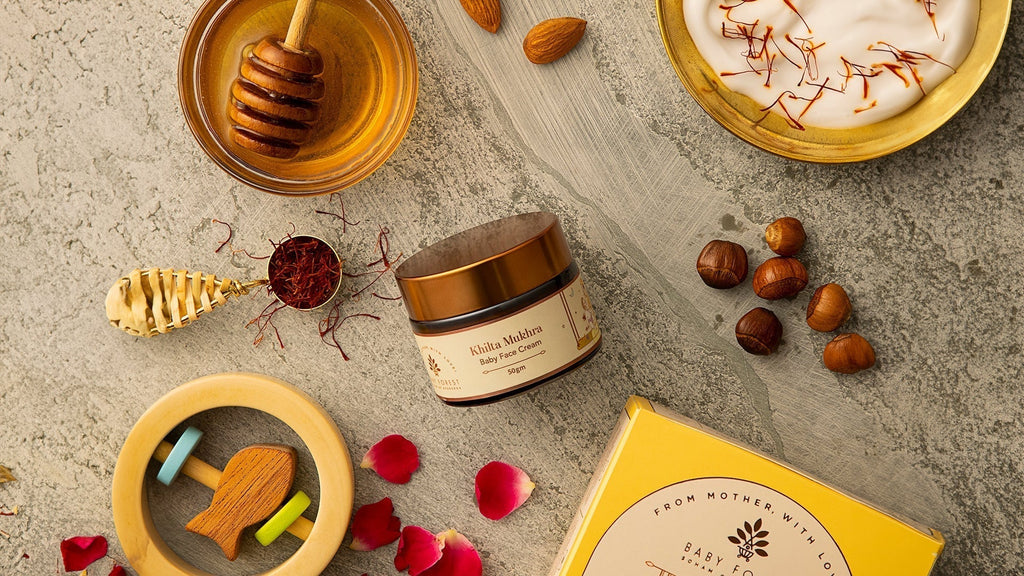
The Ultimate Guide to Baby Face Creams
Welcome to the incredible journey of parenthood, where each choice seems to hold immense significance for your precious little one. Among the pivotal decisions occupying your thoughts is the selection of the best products for your baby's well-being. Whether it's skincare or essential feeding items, as parents, you're constantly seeking the best options. However, when it comes to your baby's adorable face, have you ever considered why a regular cream might not suffice? It's a common question among parents: 'Can't we just use the same lotion we apply to their tiny toes?' The answer lies in the unique needs of your baby's facial skin. It requires a specifically formulated cream, as gentle and tender as their delicate skin demands.
The Need for Baby Face Cream
Your baby's facial skin is much thinner and more delicate than the skin on the rest of their body, akin to a soft canvas deserving of a gentle touch. Acting as a protective barrier, a good baby face cream shields their sensitive skin from harsh environmental factors. Due to the heightened sensitivity, baby faces are more susceptible to dryness and irritation. This is where a specially formulated face cream for babies comes in, helping maintain the natural moisture balance and preventing any discomfort. Unlike conventional lotions that may contain chemicals unsuitable for your baby's delicate skin, opting for a baby face cream with natural ingredients ensures you steer clear of potential irritants and allergens.
The Concerns About Chemicals in Baby Products
Traditional baby face creams often come with a side of synthetic fragrances and preservatives – not exactly what we want for our little one's delicate skin. Chemicals can be troublemakers, causing irritation or allergies. And trust us, baby skin deserves better. They can spark irritation or trigger allergies, turning a seemingly harmless skincare routine into an uncomfortable experience for your little bundle of joy. So, when it comes to choosing a baby face cream, veering away from these potential troublemakers is key.
Opting for baby face creams with natural ingredients is a conscious choice to ensure the well-being of your little one. Look for creams enriched with ingredients like shea butter, almond oil, coconut oil, mulethi, and cocoa butter. These botanical wonders not only moisturize but also possess soothing and anti-inflammatory properties, catering to the unique needs of a baby's skin.
Benefits of Natural Baby Face Cream
Using natural baby face creams isn't just a trend; it's a conscious choice for your baby's well-being. No harmful stuff, just pure, gentle care that leaves your baby's face feeling like a soft cloud. Organic ingredients work in harmony, ensuring your little one's skin stays healthy, happy, and radiant. The benefits of using natural baby face cream include providing gentle care for sensitive skin, ensuring freedom from harsh chemicals, offering anti-inflammatory properties, reducing the risk of allergies, ensuring safe everyday use, and supporting environmental friendliness.
How to Choose the Right Natural Baby Face Cream
Choosing the best organic baby face creams can be overwhelming, given the plethora of options available. But to make an informed choice, you can consider factors such as the product's ingredient list, certifications, and reputation of the brand. Look for products labelled as organic, hypoallergenic, and free from harmful additives. Read reviews or articles online to get valuable insights into the effectiveness of a particular cream. Baby Forest’s Khilta Mukhra Baby Face Cream is a luxuriously crafted cream made with Shea Butter, Kesar (Saffron), and Almond Oil that profoundly nourishes and hydrates the baby’s face while balancing and nurturing the baby’s complexion and texture.
How and When to Use a Baby Face Cream
During winter, when the air is dry and cold, it becomes even more crucial to moisturize your baby's face with the baby face cream for winter. Gently cleanse the face with a mild baby soap or cleanser, pat it dry, and then apply a small amount of the natural face cream. A pea-sized quantity is usually sufficient, and remember to focus on areas prone to dryness, such as the cheeks and forehead.
Consistency is key when it comes to skincare. Incorporate the use of baby face cream into your daily routine, preferably after bath time or before bedtime. The gentle massage involved in the application not only promotes circulation but also adds an extra layer of comfort for your little one.
Mastering the vast array of baby face creams is more than simply making a purchase; it's a thoughtful journey towards giving the greatest care to your child. Armed with the knowledge of the unique needs of your baby's delicate facial skin, you're better equipped to make informed choices. Whether you opt for a natural baby face cream to soothe and protect or prioritize gentle ingredients for your baby's well-being, the essence lies in understanding and catering to their individual requirements. As parents, we share the collective goal of nurturing our babies with the utmost care. As you start this parenting adventure armed with insights, may your choices be guided by the simple hope of seeing your little one's face glow with health, joy, and the genuine warmth of a parent's loving touch.

Gentle Cleaning: Tips for Using Baby-Safe Liquid Detergent
Welcoming a new member to the family brings immense joy and, of course, a wave of responsibilities. As new parents, ensuring the comfort and safety of your little one becomes a top priority, extending even to the laundry routine. In this article, we'll walk you through the ins and outs of gentle washing and discuss the benefits of using liquid detergent that is safe for babies. Let us help you take the best possible care of your baby's delicate clothing.
Baby clothing tends to develop more stains than adult clothing, so empower yourself on how to wash baby clothes using specially made baby detergent. Because when you consider everything, a parent has to worry about washing baby clothes and should not be one of them!
Why Choose Baby-Safe Liquid Detergent:
It can be overwhelming to choose the right product for your baby, with numerous options lining the store shelves. However, when it comes to your baby's clothes, opting for a baby-safe liquid detergent is a game-changer. Baby-safe detergents, unlike ordinary detergents, are carefully created to be mild, hypoallergenic, and free of harsh chemicals that could harm your baby's sensitive skin.
5 Benefits of Choosing a Baby-Safe Liquid Detergent:
-
Gentle on Delicate Skin:
Baby skin is incredibly delicate and prone to irritation. Baby-safe liquid detergents are specifically created for this purpose, providing a gentle yet effective cleaning solution. This ensures that your little one's clothes are free from harsh residues that might cause discomfort or allergic reactions. -
Hypoallergenic Formulas:
Infants are more susceptible to allergies, making it crucial to choose a detergent that is hypoallergenic. Baby laundry detergents are crafted to minimize the risk of allergens, providing a safe and irritation-free washing experience for your baby's clothes.
-
Mild Fragrances or Fragrance-Free Options:
While that lavender-scented laundry detergent might appeal to you, it may not be the best choice for your baby. Infant clothes detergents often come in mild fragrances or fragrance-free options, ensuring that your little one's clothes smell fresh without any overpowering scents that might be harsh on their sensitive noses. -
Effective Stain Removal:
Babies are experts at creating stains on their clothes, and tackling these stains requires an effective yet gentle detergent. Baby laundry detergents are formulated to lift stains without compromising on the gentleness required for your baby's clothes.
-
Preservation of Fabric Quality:
Your baby's clothes are often made from delicate fabrics. Using a baby-safe liquid detergent helps preserve the quality of these fabrics, ensuring that those adorable onesies and tiny socks remain soft and comfortable for your little one.
Selecting the Right Baby-Safe Liquid Detergent:
Choosing the right baby laundry detergent involves a bit of exploration. Look for products that explicitly mention being suitable for baby clothes and are free from dyes, fragrances, and harsh chemicals. Read labels carefully, opting for detergents with natural and plant-based ingredients, as these are less likely to cause irritation. Consider factors like whether your baby has sensitive skin or is prone to allergies. In such cases, fragrance-free options or detergents labelled as suitable for sensitive skin are excellent choices.
Baby Forest's Mridul Poshaak - Liquid Detergent for Baby’s Clothes is infused with the goodness of Neem Leaf Extract, Lemon Fruit Extract, Lemon Peel Oil, and a plant-based cleanser. This mild surfactant, handcrafted with care, has antibacterial characteristics that gently and thoroughly clean your baby's garments, ensuring a hygienic and delicate touch. Beyond cleanliness, it goes above and beyond to keep your child's clothes delightfully smooth.
How to Wash Your Baby's Clothes:
Hand Wash:
For hand washing, dilute one cap of baby laundry detergent in half a bucket of water and stir well. Soak your baby's clothes for 30 minutes, ensuring that the detergent penetrates and cleans effectively. After soaking, rinse thoroughly with clean water, removing any remaining detergent residue.
Machine Wash:
For a regular machine wash, pour two caps of baby laundry detergent into the washing machine. Place the dirty clothes in the machine and follow standard machine-washing protocols. This formula is suitable for both front-load and top load washing machines, ensuring a thorough and gentle cleaning process for your baby's clothes.
Conclusion
As you live through this exciting yet challenging world of parenting, every decision, no matter how small, contributes to your baby's well-being. A little but effective decision that guarantees your child's clothing is cleaned and handled with the greatest care is to use a baby detergent designed specifically for babies. It is more than just getting clothes clean; it's about making everything super comfy and caring for your little one. Consider each washes an added layer of comfort for your bundle of joy. So, let every wash be a step towards a world of comfort and care for your precious one.
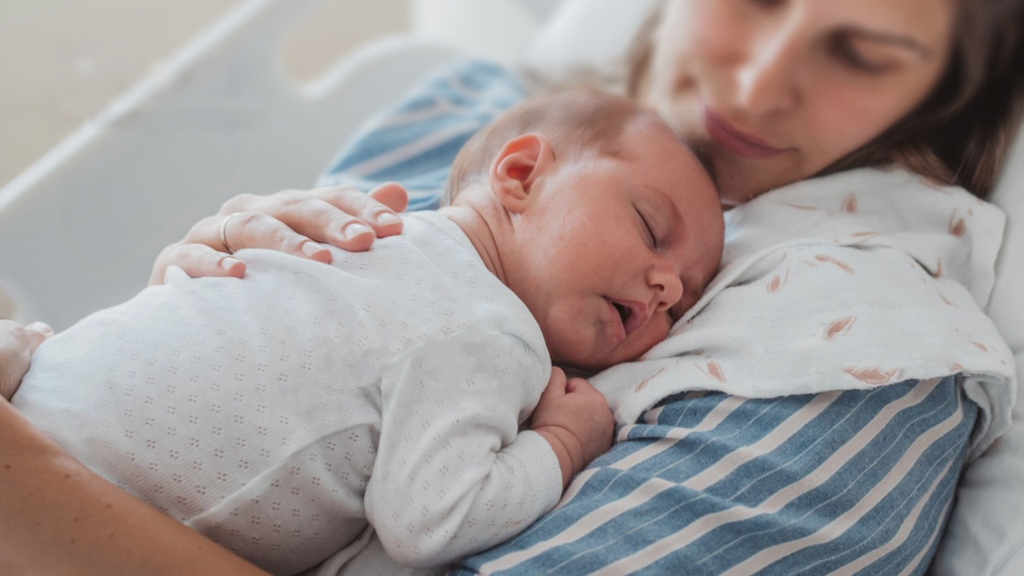
Newborn’s First 24 Hours: Essential Guide and Tips
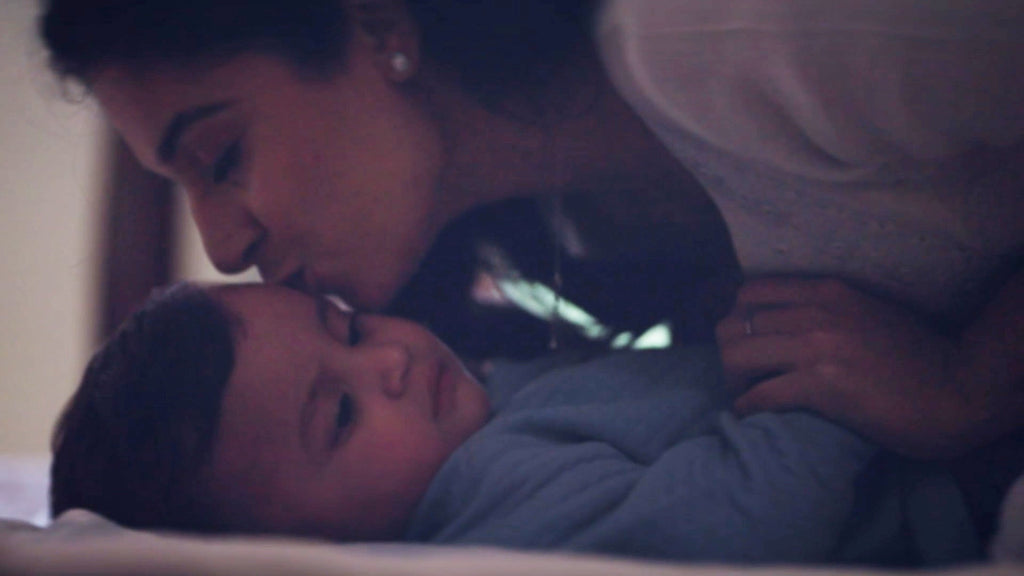
A Healthy Night Routine For Your Baby's Good Sleeping Hab...
Every new mom's most common complaint is that her baby doesn't sleep or always falls asleep at the wrong time during the day. A newborn still has a long way to go to understand the day and night cycle. The process is called the Circadian Rhythm. They have to experience the body's calmness and learn to proceed with sleeping. The ability to have a command of their body and mind is unknown to them. The predictability has to be implemented, and here's what a night routine does its wonders!
Ever wondered about the concept of the day and the night? It comes so naturally to us that we never question it. That is because we learned it so young that we couldn't question it.
A child always yearns for the calm feeling they have experienced in their mother's womb. The new surroundings are still a task for them to get adjusted to! But since the Lil ones are good learners! They will learn it all.
Why are aids bad compared to routines?
Some babies only sleep with their mom around or when their father carries them and pats them for a period. This might be helpful things for a while. But once they depend upon these means… development of bad sleeping habits in babies. It will only make things difficult for them once they grow up. What if you are not around and they want to sleep, all tired, but can't? Because of the unfamiliar absence of yours. This will irritate the child and end up being a significant issue. Some parents believe in using white sounds or a pacifier. A pacifier can indeed reduce the risk of SIDS ( a sleeping syndrome) but using it every time is a big no-no! Something from outside that makes the baby dependent is never a good choice.
Here are some good habits that you can use to calm your baby for sleep:
1. Swaddling and Lullabies: It activates calming effects and helps the child to fall asleep safely and soundly. They feel that being swaddled other than their mother's lap and lullaby is soothing.
2. Cuddles and Reading: The bedtime story is a prevalent idea. Instead, a tradition filled with good memories. It helps you bond with your child and gives them a platform to think; those stories also help you learn.
3. Bath or Massage: Some parents bathe their babies before making them asleep. It refreshes them, and massage helps their muscles to relax. Some babies feel tired after the bath routine and fall asleep out of tiredness. A good massage with Baby Forest Masoom Maalish Oil and champi with Nanhi champi hair massage oil will comfort the baby and soothe them for a good sleep.
At the age of 8-10 months, One should start a little bedtime routine for their child. It doesn't have to be a long one….with multiple steps, but just small habits like this that can stimulate the child about the next task; being asleep should be the motive, and you are all good to go! Sleeping habits hold importance right from the start. Inducing good habits is a journey that requires patience. But it remains with your child forever.
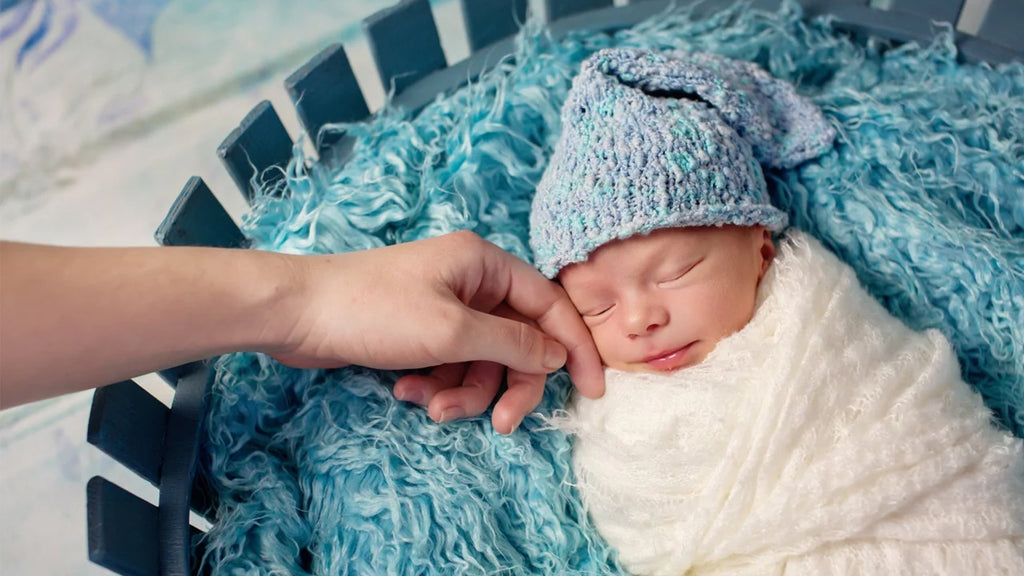
Prepare Your Baby for Winter: Tips for Dry Skin Care
As parents, we know how delicate our little ones’ skin is, but winter can make their skin even more vulnerable. The cold weather brings along dryness and can cause various baby skin care issues. From chapped cheeks to rough patches, winter can be tough on your baby's skin. While we can't control the weather, we can protect our baby's skin and keep it well-nourished during the colder months.
The good news? Taking care of your baby's skin during winter doesn't mean using lots of products—it's about using the right ones! Natural, gentle solutions are often the best. Here are some simple, tried-and-tested tips to help you with winter care for your newborn baby.
Moisturize With the Best Baby Face Cream for Winter
One of the biggest challenges for new moms is finding the right baby face cream for winter. It's tempting to go for products with trendy ingredients like hyaluronic acid, but for babies, it's best to stick with natural formulas. Your baby's skin is extra sensitive because it lacks the protective barrier that older skin has, so choosing products with natural oils is safer.
Make sure to moisturize your baby's skin daily, especially after baths and before going outside in the cold. Baby Forest Moh Malai Baby Body Lotion is an excellent choice—it's packed with natural ingredients like shea butter, coconut oil, almond oil, and pomegranate seed oil, which provide deep hydration while being gentle on your baby's skin. Regular use will keep your baby's skin soft, smooth, and protected from winter dryness.

Baby Skincare in Winter: Ease Off on Bath Time
During the colder months, it's important to rethink your baby's bath routine. If your baby is a newborn or an infant, there's no need for long or frequent baths. Winter care for newborn baby skin means avoiding too much exposure to water, which can dry out their delicate skin. Also, consider skipping bubble baths, as they can strip away natural oils.
Instead, choose a gentle, moisturizing soap like Baby Forest Nirmalya Snan Natural Baby Soap, which is made with jojoba oil, sesame oil, and castor oil. These natural ingredients will cleanse your baby's skin without causing dryness and will leave it soft and nourished. After the bath, be sure to pat your baby dry gently and apply a baby cold cream for winter to lock in moisture.
Dress Right for Winter Baby Care: Clothing and Temperature
We often think that layering our babies in thick clothes will protect them from the cold, but too many layers can cause discomfort and friction. Choose soft, breathable fabrics and avoid heavy materials that can irritate the skin. Woolens should be cleaned with a gentle detergent, like Baby Forest Mridul Poshaak Liquid Detergent, to keep them soft and free of harsh chemicals that could irritate your baby's sensitive skin.
It's also important not to overheat your home. While it's tempting to keep the house warm, too much heat can actually dry out the air, leading to dry skin and irritation. Maintaining a balanced, moderate temperature is part of proper baby skin care in winter.
Massage Your Baby with the Best Oil for Baby's Skin
Massaging your baby not only provides warmth but also boosts circulation, which is especially important in winter. Using the best oil for baby skin, like cold-pressed almond oil, can lock in moisture and keep your baby's skin hydrated. Almond oil is light and non-sticky, making it perfect for massaging your baby without leaving them feeling greasy.
Baby Forest Badami Sneh Organic Cold-Pressed Almond Oil is a great choice—it's highly absorbent, making it easier for moms to massage their babies while keeping their skin soft and nourished. Regular massages also help soothe your baby and can be a wonderful bonding experience.
Additional Tips for Winter Baby Care
Here are some extra tips to keep your baby's skin healthy and comfortable throughout the colder months:
-
Hydrate from the inside:
While your baby may not need as much water as older children, make sure they're getting enough fluids to stay hydrated. This helps keep their skin moisturized from within.
-
Protect from wind:
When taking your baby outside, cover their face with a soft scarf or blanket to shield their skin from the cold wind, which can cause chapping and irritation.
-
Diaper changes:
Even during winter, diaper rashes can still happen due to the lack of airflow and moisture buildup. Be sure to use a good barrier cream and change diapers frequently.
Conclusion
Winter can be tough on your baby's delicate skin, but with the right baby skincare in winter, you can keep dryness and irritation at bay. Stick to natural products, limit bath time, and make sure to moisturize regularly. Don't forget the importance of gentle massages with the best oil for baby skin, like almond or coconut oil, to help keep your baby's skin healthy and soft.

5 Must-Know Tips For Your Baby’s First Winter
As much as baby’s first things bring happiness to their parents, they are escorted by a lot of worries and anxiety. Especially for new parents who are in the process of discovering the right and wrong choices for a child. When it comes to winter, it is more than the weather. For adults, it is the time of the year when they can sunbath with their family members, eat all those healthy greens, gur, ladoos made by Dadis and Nanis what not!, the time to snuggle themselves in layers of quilts, and seek comfort like a baby. But for the little ones, it is harsher than the adults. They might not enjoy the coziness that winter carries with it. Their immunity and delicacy is more vulnerable in cold. But a small checklist of what you should prepare for your baby’s first winter will embrace comfort and warmth for them.

#1 A Massage A Day Will Keep The Cold Away
A massage for a little one is a wonder tip! It shields the delicacy of the baby packed with strength and nutrients. Cold weather stiffens the muscles and babies have even lesser muscle mass than adults so it is much more difficult for them to move freely. Almond Oil has the perfect nature and tempera for massage on those cold days. Baby Forest Badami Sneh Almond Oil is full of warmth and helps with the proper circulation of blood. It also works as a natural moisturizer that protects the fragile skin of the baby from being chapped off.

#2 Heavy Layers Are Never A Good Idea
We try to layer up the little ones with the good intention of protection but we forget that the weight is too much work for them. Secondly, it restricts them from setting their bodied in free motion which makes them vulnerable to Sudden Infant Death Syndrome.

#3 Breastfeed Is A Defense
When we say that: No one protects a child better than a mother; breastfeeding is one of the root reasons that support this fact! Breast milk is full of antibodies and boosts the immunity of a baby. And we all know how the months after the fall are followed by the cold and cough. Natural Antibodies provided by the milk are resistant to infections. Even for older babies, we have a solution! Baby Forest Komal Shwas vapor rub helps them to breathe easily and promotes better sleep.

#4 Give Them A Bath But Alternatively!
If you are afraid of bathing your baby in winters, don’t be! Lukewarm water is a completely safe option and is even essential to maintain the hygiene of a baby. But, exposing them to water every day might not be a wise choice. Choosing a suitable hour which is not too cold will avoid catching a cold and cough.

#5 Nature’s Bath Is The Best Bath
Who doesn’t love those warm, cozy, and glowing sunrays falling through the window? Well, nature has its shield all set for your baby. The best time to seek comfort from the sun is from 10 am to 3 pm. Rather than protecting your baby from the sun every time…exposure to the sun is very important for the absorption of vitamin D.
Note: Do not expose the baby for more than 30 minutes and seek a doctor’s help in case of any skin condition.




